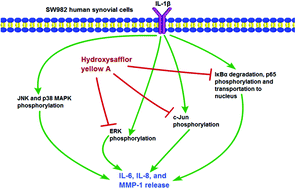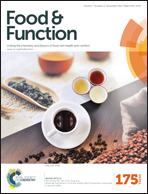Hydroxysafflor yellow A inhibits IL-1β-induced release of IL-6, IL-8, and MMP-1 via suppression of ERK, NF-κB and AP-1 signaling in SW982 human synovial cells
Abstract
Hydroxysafflor yellow A (HSYA), the main active ingredient in medical and edible dual purpose plant safflower, is reported to have multiple bioactivities. In the present study, the anti-inflammatory effects of HSYA and the underlying mechanisms were investigated in interleukin (IL)-1β-induced SW982 human synovial cells. The cells were pretreated with HSYA at various concentrations (2.5, 10 and 40 μM) followed by IL-1β (10 ng mL−1) stimulation. HSYA significantly inhibited the expression of IL-6, IL-8 and matrix metalloproteinase (MMP)-1 in IL-1β-stimulated SW982 cells. HSYA also inhibited the phosphorylation of extracellular signal-regulated kinase (ERK), p65 and c-Jun. It also suppressed the degradation of IκBα and blocked p65 translocation into the nucleus. These results indicate that the inhibitory effects of HSYA on IL-1β-induced IL-6, IL-8 and MMP-1 release might be mediated via suppression of ERK, nuclear factor-κB (NF-κB) and activator protein-1 (AP-1) signaling pathways. The present data support the potential role of HSYA as an effective therapeutic agent in osteoarthritis.


 Please wait while we load your content...
Please wait while we load your content...